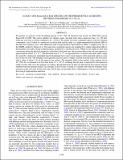| dc.contributor.author | Lin, Dacheng | |
| dc.contributor.author | Homan, Jeroen | |
| dc.contributor.author | Remillard, Ronald A | |
| dc.date.accessioned | 2015-03-04T20:47:23Z | |
| dc.date.available | 2015-03-04T20:47:23Z | |
| dc.date.issued | 2010-08 | |
| dc.date.submitted | 2009-09 | |
| dc.identifier.issn | 0004-637X | |
| dc.identifier.issn | 1538-4357 | |
| dc.identifier.uri | http://hdl.handle.net/1721.1/95828 | |
| dc.description.abstract | We present an analysis of the broadband spectra of 4U 1705-44 obtained with Suzaku in 2006-2008 and by BeppoSAX in 2000. The source exhibits two distinct states: the hard state shows emission from 1 to 150 keV, while the soft state is mostly confined to be <40 keV. We model soft-state continuum spectra with two thermal components, one of which is a multicolor accretion disk and the other is a single-temperature blackbody (BB) to describe the boundary layer, with additional weak Comptonization represented by either a simple power law or the SIMPL model by Steiner et al. The hard-state continuum spectra are modeled by a single-temperature BB for the boundary layer plus strong Comptonization, modeled by a cutoff power law. While we are unable to draw firm conclusions about the physical properties of the disk in the hard state, the accretion disk in the soft state appears to approximately follow L [proportional to] T [superscript 3.2]. The deviation from L [proportional to] T [superscript 4], as expected from a constant inner disk radius, might be caused by a luminosity-dependent spectral hardening factor and/or real changes of the inner disk radius in some part of the soft state. The boundary layer apparent emission area is roughly constant from the hard to the soft states, with a value of about 1/11 of the neutron star surface. The magnetic field on the surface of the neutron star in 4U 1705-44 is estimated to be less than about 1.9 × 10[superscript 8] G, assuming that the disk is truncated by the innermost stable circular orbit or by the neutron star surface. Broad relativistic Fe lines are detected in most spectra and are modeled with the diskline model. The strength of the Fe lines is found to correlate well with the boundary layer emission in the soft state. In the hard state, the Fe lines are probably due to illumination of the accretion disk by the strong Comptonization emission. | en_US |
| dc.description.sponsorship | United States. National Aeronautics and Space Administration (NASA Grant NNX08AC02G, Suzaku guest observer program) | en_US |
| dc.description.sponsorship | United States. National Aeronautics and Space Administration (NASA contract to MIT for RXTE instruments) | en_US |
| dc.language.iso | en_US | |
| dc.publisher | Institute of Physics/American Astronomical Society | en_US |
| dc.relation.isversionof | http://dx.doi.org/10.1088/0004-637x/719/2/1350 | en_US |
| dc.rights | Article is made available in accordance with the publisher's policy and may be subject to US copyright law. Please refer to the publisher's site for terms of use. | en_US |
| dc.source | American Astronomical Society | en_US |
| dc.title | SUZAKU AND BeppoSAX X-RAY SPECTRA OF THE PERSISTENTLY ACCRETING NEUTRON-STAR BINARY 4U 1705-44 | en_US |
| dc.type | Article | en_US |
| dc.identifier.citation | Lin, Dacheng, Ronald A. Remillard, and Jeroen Homan. “ SUZAKU AND BeppoSAX X-RAY SPECTRA OF THE PERSISTENTLY ACCRETING NEUTRON-STAR BINARY 4U 1705-44 .” The Astrophysical Journal 719, no. 2 (July 28, 2010): 1350–1361. © 2010 American Astronomical Society. | en_US |
| dc.contributor.department | MIT Kavli Institute for Astrophysics and Space Research | en_US |
| dc.contributor.mitauthor | Lin, Dacheng | en_US |
| dc.contributor.mitauthor | Remillard, Ronald Alan | en_US |
| dc.contributor.mitauthor | Homan, Jeroen | en_US |
| dc.relation.journal | Astrophysical Journal | en_US |
| dc.eprint.version | Final published version | en_US |
| dc.type.uri | http://purl.org/eprint/type/JournalArticle | en_US |
| eprint.status | http://purl.org/eprint/status/PeerReviewed | en_US |
| dspace.orderedauthors | Lin, Dacheng; Remillard, Ronald A.; Homan, Jeroen | en_US |
| mit.license | PUBLISHER_POLICY | en_US |
| mit.metadata.status | Complete | |
